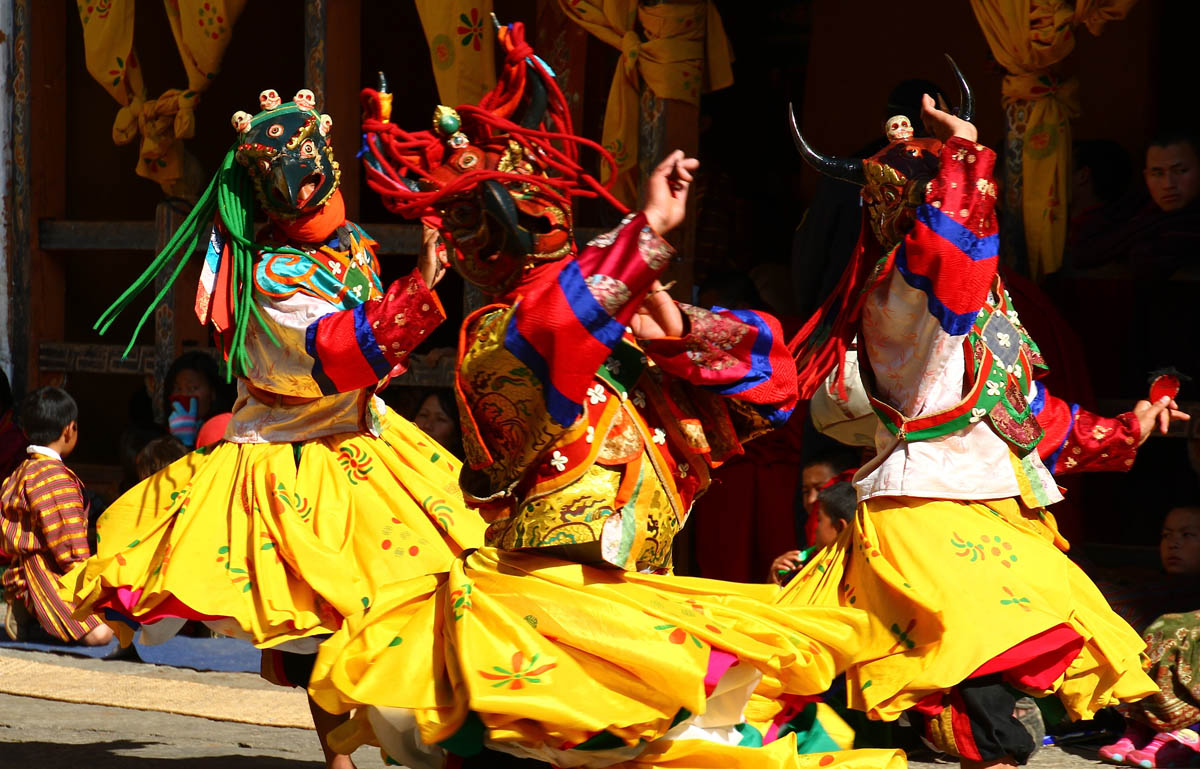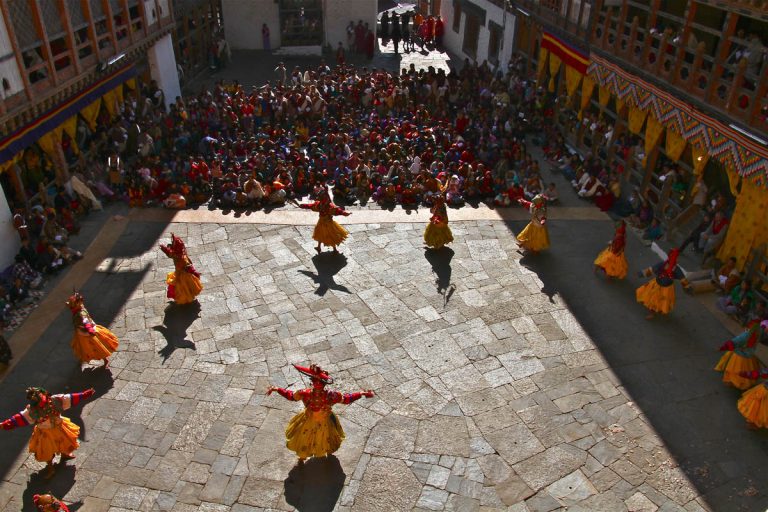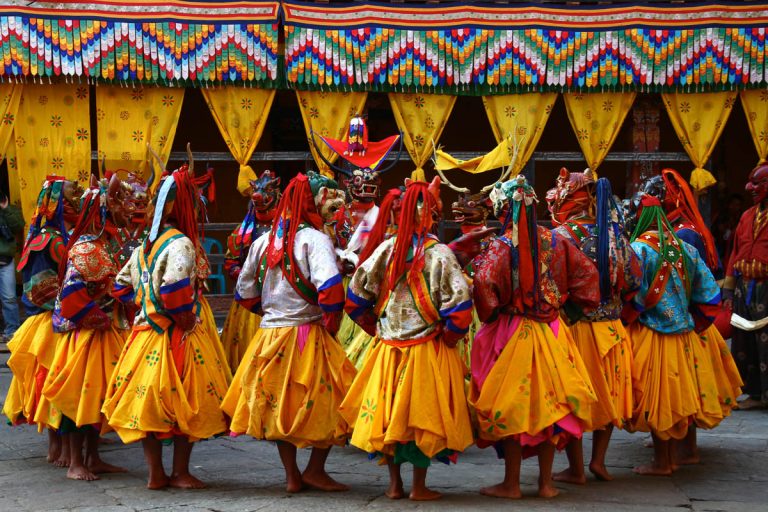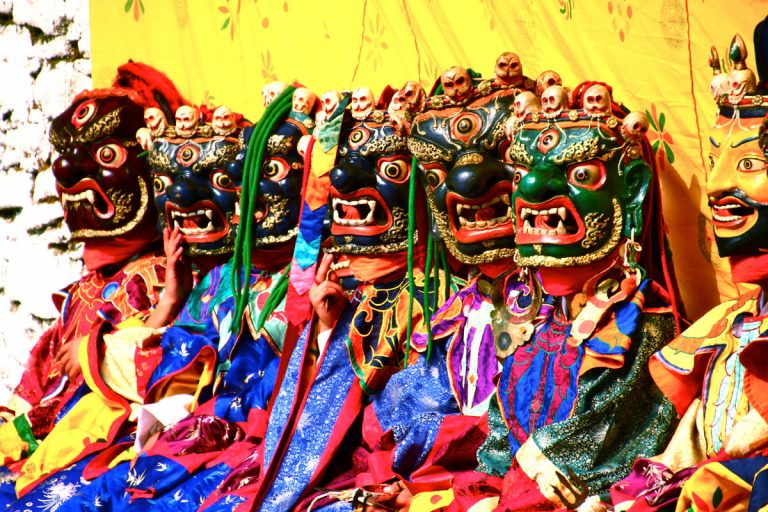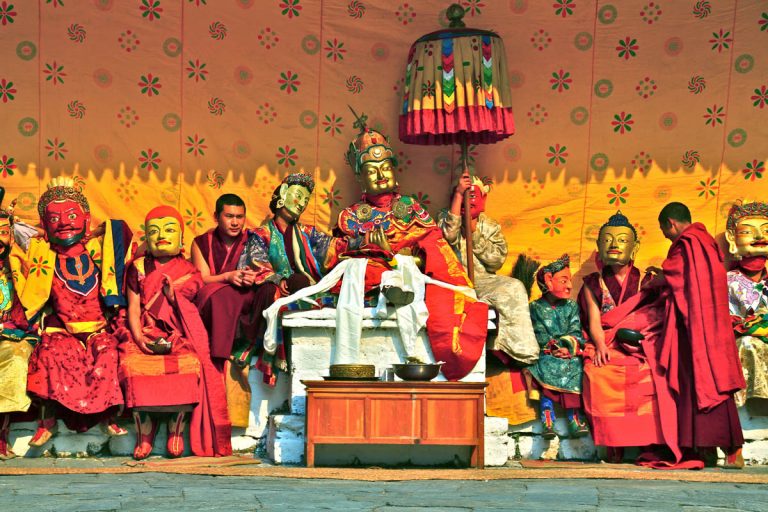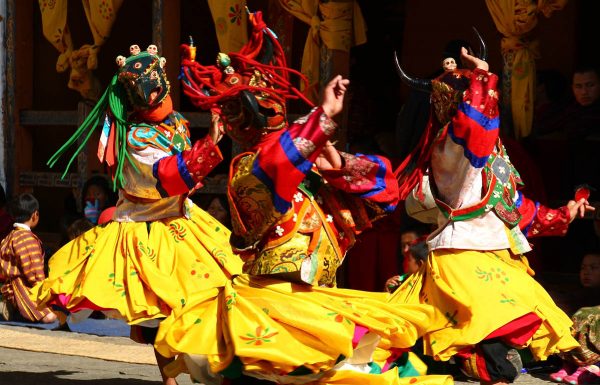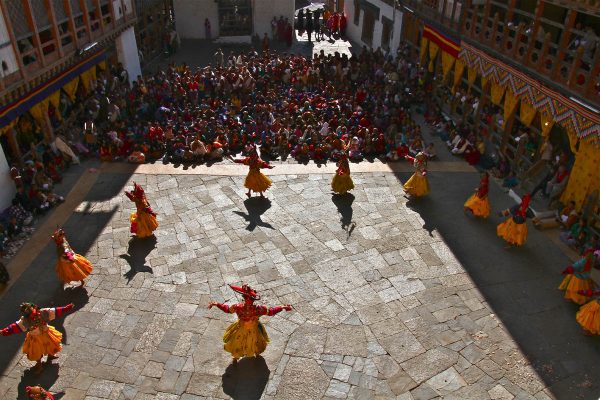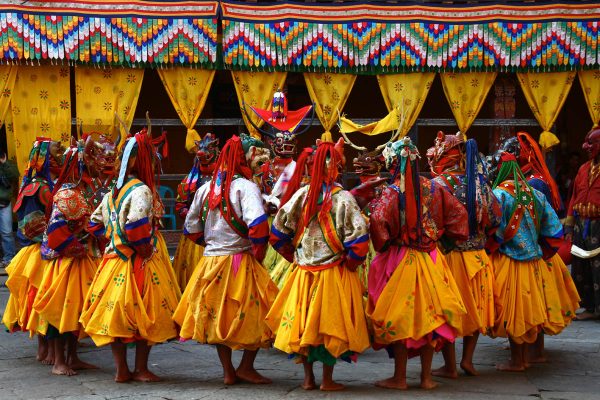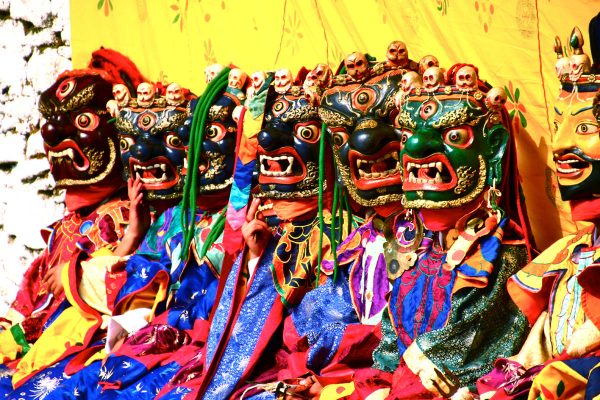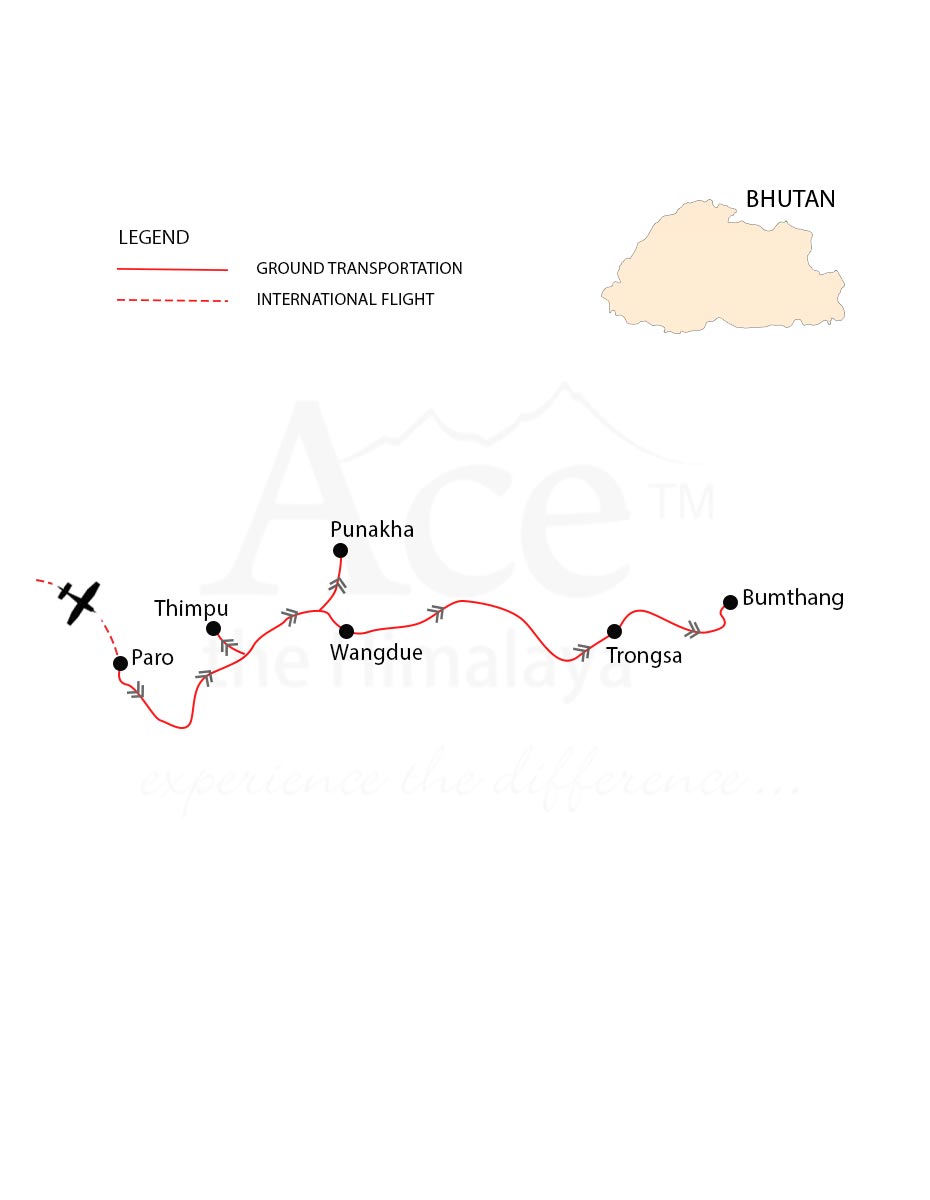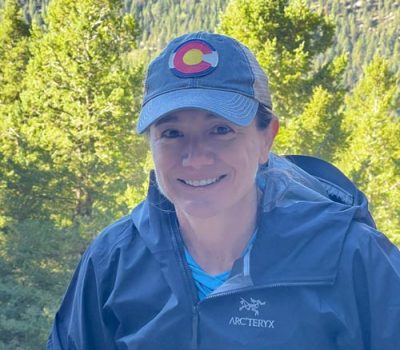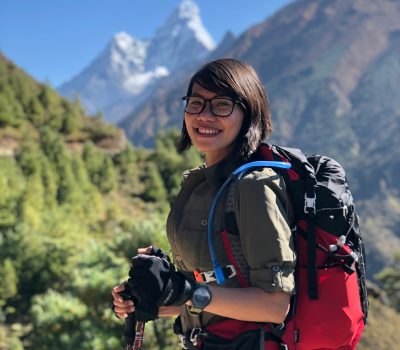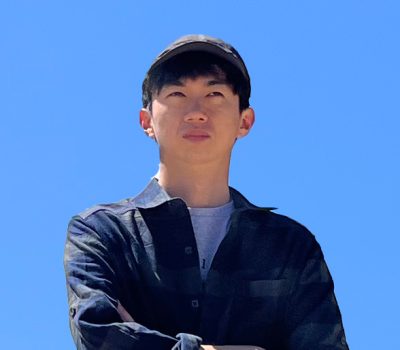Trongsa Lhuntse Tshechu - 11 Days
The Trongsa Lhuntse Tshechu is a vibrant and deeply spiritual festival held to honor Guru Padmasambhava, "the one born of a lotus flower.” This Tshechu is an immersive celebration honoring religious rituals and cultural preservation
Trip Highlights
- Immerse in the unique culture of Bhutan’s iconic destinations: Thimphu, Trongsa, Bumthang, and Paro
- Hike to Bhutan’s most sacred and iconic cliffside monastery, Taktsang Monastery (Tiger’s Nest)
- Explore historical Trongsa Dzong, Bhutan’s largest fortress
- Experience the rich culture in the colorful festival celebrations
- Witness sacred mask dances and vibrant costumes reflecting Bhutan’s timeless spiritual heritage.
- Soak in the breathtaking Himalayan vistas and serene alpine valleys from scenic viewpoints
- Wander through local markets showcasing traditional handcrafted Bhutanese arts and crafts
Trip Overview
The Trongsa Lhuntse Tshechu is a deeply revered festival held in honor of Guru Padmasambhava, the legendary saint also known as the “one who was born from a Lotus Flower.”
Around 800 AD, Guru Rinpoche played a crucial role in spreading Tantric Buddhism throughout the Himalayan regions of Tibet, Nepal, and Bhutan, profoundly shaping the spiritual landscape of the region.
Guru Rinpoche was recognized as the founder of the Nyingmapa, the oldest school of Tibetan Buddhism.
Guru Rinpoche’s life and teachings continue to inspire generations of Bhutanese practitioners. His biography is traditionally depicted through 12 significant episodes, mirroring the life of Buddha Shakyamuni.
These events are celebrated in Bhutan throughout the year, each commemorated on or around the 10th day of the lunar month, known as Tshechu.
The Tshechu is not only a religious festival where monks and laypeople perform sacred masked dances rich in symbolism and spiritual meaning but also a vibrant social gathering.
Communities come together dressed in their finest traditional attire to receive blessings, gain spiritual merit, and celebrate with joy and reverence.
Held in the spiritual and cultural heartlands of Trongsa and Lhuntse, this festival offers visitors an unforgettable window into Bhutan’s profound religious heritage, colorful traditions, and communal harmony.
In addition to witnessing the vibrant Trongsa Lhuntse Tshechu festival, this journey offers immersive cultural sightseeing through the scenic valleys of Thimphu, Trongsa, Bumthang, and Paro.
Discover ancient fortresses, sacred temples, and a tapestry of living traditions as you traverse some of Bhutan’s most enchanting valleys.
Soak in stunning Himalayan landscapes, wander through charming villages, and engage with the local lifestyle of this Himalayan kingdom.
This culturally enriching Bhutan tour is your gateway to experience the authentic rhythms, history, and traditions of the Land of the Thunder Dragon.
Short Itinerary
December 25 – Arrival at Paro Airport (2250 m/7,382 ft) then transfer to Thimphu (2,330 m/7,644 ft) – 1 to 2 hours drive. Overnight at a 3-star hotel.
December 26 – Sightseeing around Thimphu (2,330 m/7,644 ft). Overnight at a 3-star hotel.
December 27 – Drive to Punakha (1,200 m/3,937 ft) from Thimpu – 2 to 3 hours drive. Overnight at a 3-star hotel.
December 28 – Drive to Trongsa (2,400 m/7,874 ft) from Punakha – 4 to 5 hours drive Overnight at a 3-star hotel.
December 29 – Full-day exploration at Trongsa festival (2,400 m/7,874 ft). Overnight at a 3-star hotel.
December 30 – Drive to Bumthang (2,700 m/8,858 ft) from Trongsa – 2 to 3 hours drive. Overnight at a 3-star hotel.
December 31 – Full-day Sightseeing in Bumthang (2,700 m/8,858 ft). Overnight at a 3-star hotel.
January 01 – Drive to Wangdue (1,270 m/4,167 ft) from Bumthang – 5 to 6 hours drive. Overnight at a 3-star hotel.
January 02 – Drive to Thimphu (2,330 m/7,644 ft) from Wangdue – 2 to 3 hours drive. Overnight at a 3-star hotel.
January 03 – Morning drive to Paro from Thimphu – 1 to 2 hours drive then excursion to Taktsang Monastery/ Tigers Nest Monastery (3,120 m/10,232 ft) – 20 minutes’ drive then 5-6 hours hike. Overnight at a 3-star hotel.
January 04 – Transfer to the international airport for your final departure.
Departures & Availability
Please select the fixed departure date from the calendar below to join this festival tour. As there is only one scheduled date aligned with the festival, simply follow the steps to confirm your booking.
Please select the fixed departure date from the calendar below to join this festival tour. As there is only one scheduled date aligned with the festival, simply follow the steps to confirm your booking.
Looking for personalized experience? We organize privately guided journey which is mainly designed to fit your taste and interest. Please fill out the form below to get started.
Price Includes
Accommodation
- Standard government-approved 3-star accommodation (in twin-sharing rooms) for the duration of the tour.
Meals and Drinking Water
- Full-board meals – 10 breakfasts, 10 lunches, 10 dinners, and tea & snacks – for the duration of your stay.
- Unlimited supply of packaged drinking water for the duration of the tour.
Transportation
- All (international and domestic) airport transfers on a tourist vehicle
- Private transportation and a designated driver within Bhutan. SUV vehicles for solo/pairs, Hiace vans for small groups, and Coaster buses for larger groups.
Guide and Staff
- Licensed English-speaking and first-aid experienced Bhutanese tour guides. Additional or assistant guides are provided for groups over 11 or when special support is needed, such as for senior travelers.
- Guided city tour in Paro by private tourist vehicle.
- The required number of local staff and porters to carry your luggage during the trip.
- Wages, accommodation, meals, gear, insurance, and medications for all staff
Permits and Fees
- Bhutan visa fees and processing assistance.
- All route access and monument entry permits and fees.
- Monument and museum entrance fees for all sightseeing locations are detailed in the itinerary.
- Government-mandated Sustainable Development Fee of US$100 per person per night.
Benefits and Takeaways
- Country presentation and tour Briefing on the evening of Day 1 with welcome drinks.
- Cultural afternoon/evening sessions with traditional masks and folk dances (with beverages). [Only for group tours.]
- 1 Ace the Himalaya’s duffel/kit bag, sun hat, and Buff (Neck Gaiter) if your flight originates from Kathmandu, Nepal.
Administrative & Taxes
- All government taxes, official expenses, and tourist service charges.
Price Excludes
- All international airfare, including Druk Air flights and airport departure tax
- Travel insurance, along with high-altitude emergency evacuation coverage.
- Alcoholic drinks and beverages.
- Tips for tour guides, porters, drivers, hotel lobby, and restaurants. (Tipping is expected).
- All items of a personal nature like laundry, gear, shopping, etc.
- Any expenses other than the Price Include section.
Detailed Itinerary
Expand AllDay 01: : December 25 - Arrive in Paro and transfer to Thimphu
You’ll fly into Paro International Airport, Bhutan’s only international gateway, with direct flights from cities like Kathmandu, Bangkok, New Delhi, and Dhaka.
For the smoothest and most scenic experience, we recommend flying Kathmandu–Paro–Kathmandu.
It not only makes logistics easier but also allows us to personally greet you with gratitude and offer some thoughtful travel gear or souvenirs, including a duffle bag, sun hat, and neck gaiter, which are yours to keep as part of the journey.
As you soar through the Himalayas, you’ll witness jaw-dropping views of snow-capped giants, including Mount Everest, before landing in the stunning Paro Valley at 2,250 m (7,382 ft).
This fertile region is known for its golden rice fields, apple orchards, and fresh organic produce. Once you land, our airport representative will be there to welcome you with a traditional silk khada, a Bhutanese gesture of good luck and warm hospitality.
After completing arrival formalities, you’ll embark on a scenic one to two-hour drive to Thimphu, Bhutan’s charming capital.
As you journey onward, you’ll travel past lush terraced rice fields, traditional farmhouses, and charming mountain villages, each offering panoramic views of serene valleys.
Arriving in Thimphu, the quiet charm of Bhutanese life welcomes you. With just a few main streets lined with local shops and cozy cafes, the atmosphere is peaceful and unhurried, offering a glimpse into the Bhutan’s tranquil way of life.
Day 02: December 26 - Sightseeing around Thimphu
After a hearty breakfast, we begin our immersive cultural exploration with exploration to the House of Incense and House of Paper, where you’ll witness the fascinating traditional processes of handcrafting incense and paper from natural Bhutanese materials.
Next, we visit the National Memorial Chorten, built in honor of Bhutan’s revered Third King, who ruled from 1952 to 1972. This ancient whitewashed stupa which is rich in symbolism and devotion is a vibrant center of daily spiritual practice for locals.
We’ll also stop at Changlimithang Lhakhang and the Handicrafts Emporium, offering a wide selection of locally made crafts.
After lunch, our journey continues at the Textile Museum, where you’ll gain a deeper appreciation for Bhutan’s remarkable textile traditions.
The museum showcases intricate embroidered and applique fabrics used in sacred ceremonies, alongside beautifully preserved thangkas and altar cloths.
The upper gallery highlights masterpieces from the Royal Family, celebrating the richness and diversity of Bhutanese weaving.
We end the day with a visit to Bhutan’s National Library, home to a treasured collection of ancient manuscripts and religious scrolls that reflect the kingdom’s deep spiritual and cultural heritage.
Day 03: December 27 - Drive to Punakha from Thimpu
After a warm breakfast, we bid farewell to Thimphu and begin our scenic 2 to 3-hour journey toward the serene Punakha Valley.
The road gently ascends through forests of pine and cedar, and their branches draped in strands of delicate lichen.
As we ascend, the landscape rewards you with a botanical tapestry of blooming rhododendrons, magnolias, and evergreen junipers, accompanied by the songs of rare Himalayan bird species.
We soon arrive at the breathtaking Dochula Pass, perched at 3,050 meters (10,006 ft). On clear mornings, this spot offers sweeping panoramic views of the snow-capped Himalayan range.
Continuing our descent, we enter the fertile Lobesa Valley, where we enjoy a short and peaceful walk through lush terraced rice fields to visit Chimi Lhakhang, the famed Temple of Fertility.
This temple was built in honor of the eccentric 14th-century saint Drukpa Kuenley, affectionately known as the Divine Madman, this hilltop temple is revered by locals and travelers alike, especially those seeking blessings for fertility.
In the afternoon, we reach Punakha Dzong, one of Bhutan’s most magnificent fortresses, elegantly situated at the confluence of the Mo Chhu and Po Chhu rivers.
This architectural masterpiece serves as the winter residence of the monastic body and the Je Khenpo (Chief Abbot) and stands as a timeless symbol of Bhutanese spiritual heritage and cultural preservation.
Day 04: December 28 - Drive to Trongsa from Punakha
After an early breakfast, we begin our memorable journey eastward into the heart of Bhutan, setting off on a scenic 4 to 5-hour drive toward Trongsa.
Our route takes us through the historic town of Wangdue Phodrang, where we pause briefly to admire the Wangdue Phodrang Dzong perched on a ridge overlooking the confluence of the Tsang Chu and Dang Chu rivers.
From here, the road climbs steadily, winding through lush semi-tropical forests and gradually transitioning into cool alpine vegetation rich with rhododendrons and dwarf bamboo.
We soon reach the stunning Pele La Pass (3,300 m/10,826 ft), traditionally considered the boundary between western and central Bhutan. The pass is Marked by fluttering prayer flags and distinctive white chorten.
On clear days, we may be rewarded with sweeping views of the Himalayan peaks, including the majestic Jhomolhari (7,314 m/23,998 ft) rising to the west.
Our journey continues as we descend to the tranquil Chendebji Chorten (2,430 m/7,972 ft), where we stop for lunch.
This monument which was built in the 18th century by Lama Shida of Tibet, is a stunning monument with eyes painted on all four sides in Nepalese style is said to have been constructed to subdue a malevolent spirit that once plagued the region.
The road then winds dramatically along steep cliffs and forested ridges, offering ever-changing vistas of Bhutan’s untouched landscape.
As we come near Trongsa, the mighty Trongsa Dzong emerges from the mountainside, one of Bhutan’s most magnificent fortress-monasteries.
Day 05: December 29 - Full-day exploration at Trongsa festival
Today, we immerse ourselves in the vibrant atmosphere of the Trongsa Tshechu, a captivating celebration of Bhutanese spirituality, culture, and local community.
This festival is held within the majestic walls of the Trongsa Dzong rewarding you with an unforgettable glimpse into the living traditions of the Land of the Thunder Dragon.
Trongsa Dzong was built in 1648 AD by Chogyel Minjur Tempa, the third Desi (secular ruler), and is both a historic stronghold and the present-day administrative and monastic center of the district.
The fortress unfolds across multiple levels an architectural marvel with breathtaking views of the surrounding valleys, rivers, and winding mountain roads.
Overlooking the Dzong is the ancient watchtower, a medieval sentinel that once safeguarded the region.
As the festival unfolds, prepare to be mesmerized. Colorful brocades swirl in the air as masked dancers perform sacred dances, including the powerful “Thunderbolt Step,” symbolizing the triumph of wisdom over evil.
Fierce masks of protective deities and mythical animals ignite your senses (Goosebumps) as purification takes place.
The rhythm of the drums, the fluttering of prayer flags, and the devotion of the locals transport you into medieval Bhutan.
Be sure to capture the magic with your camera, and more importantly, with your heart. After a soul-stirring day, we conclude with a warm and relaxing dinner at a local restaurant, reflecting on the rich heritage and spiritual energy of the day.
Day 06: December 30 - Drive to Bumthang from Trongsa
Today begins with a cultural immersion at the Trongsa Festival, where we’ll witness a half-day of vibrant masked dances and spiritual rituals held in the magnificent Trongsa Dzong.
After lunch, we embark on a scenic drive toward Bumthang, covering 79 kilometers in approximately 2-3 hours. This scenic journey takes us through some of Bhutan’s most picturesque and spiritually significant landscapes.
We ascend to the Yutong La Pass (3,400 m/11,155 ft), where forests of fir and spruce blanket the hillsides, before descending into the Chumey Valley.
Continuing our journey, we pass through the tranquil Kiki La Pass (2,860 m/ 9,383 ft), before arriving in the Choekhor Valley of Bumthang.
Bumthang, often referred to as the spiritual heartland of Bhutan, is sprouted with sacred temples and monasteries where great Buddhist masters, the Guru, and his lineage of Tertons (treasure finders) meditated and left in their wake many sacred grounds.
In the evening, enjoy a relaxed stroll through the charming town of Bumthang.
Day 07: December 31 - Full-day Sightseeing in Bumthang
Today is dedicated to discovering the cultural and spiritual essence of Bumthang Valley often considered the sacred heartland of Bhutan.
Bumthang is home to some of Bhutan’s most important temples, monasteries, and historical landmarks revered for its tranquil beauty and deep religious significance.
Our exploration begins at the historic Jakar Dzong, meaning “Fortress of the White Bird.”
We then visit Jambay Lhakhang, one of Bhutan’s oldest and most sacred temples, believed to have been built in the 7th century by Tibetan King Songtsen Gampo to subdue a demoness and propagate Buddhism.
Next, we make our way to Kurje Lhakhang, a sacred site where Guru Rinpoche meditated and left his body imprinted on a rock. We then continue to Tamshing Lhakhang where inside, ancient murals depict 1,000 Buddhas and 21 Taras.
In the village, you’ll have the opportunity to meet local weavers working on traditional backstrap looms. This is one of the best places in Bhutan to purchase authentic textiles and encounter Bhutanese craftsmanship.
Later, we take a short walk to the serene Flaming Lake (Mebar Tsho) and the traditional stone flour mill powered by water.
We’ll then visit a Swiss-run farm that produces a range of local artisan products including cheese, honey, apple juice, and the famed Red Panda Weiss Beer. This will help you insight into how traditional Bhutanese practices blend with sustainable innovation.
In the evening, we’re welcomed into a local farmhouse where you can experience Bhutanese hospitality firsthand. The day concludes with leisurely stroll through Chamkhar town before returning to the lodge for a dinner and a night’s rest.
Day 08: January 01 - Drive to Wangdue from Bumthang
After morning breakfast, we depart our journey from Bumthang and then shift westward toward Wangdue.
Immerse in this picturesque journey while enjoying scenic valleys, dramatic ridgelines, breathtaking landscapes, and scenic photo stops along the way.
In Trongsa, we may pause to witness a lively archery match which is the national sport of Bhutan before continuing on.
After a 5-6 hours drive we reach beautiful Wangdue Valley surrounded by rivers and verdant landscapes. The day concludes with an overnight at a comfortable hotel in Wangdue.
Day 09: January 02 - Drive to Thimphu from Wangdue
Today after morning breakfast, we prepare to leave Wangdue and drive towards Bhutan’s Capital, Thimphu.
Upon arrival in Thimphu after 2-3 hours drive, we check into our hotel and enjoy a relaxed afternoon exploring Bhutan’s charming capital.
The afternoon is yours to explore. You can take a leisurely stroll through the city’s lively streets, browse local shops, cafes, and artisan markets, or visit cultural landmarks.
If you have something to purchase you can browse into local shops. You can perhaps buy a piece of traditional art, hand-woven textile, or Bhutanese handicraft. Feel free to ask your expert local guide for personalized assistance.
Day 10: January 03 - Morning drive to Paro from Thimphu then excursion to Taktsang Monastery/ Tigers Nest Monastery
After breakfast, we bid farewell to Thimphu and drive toward the serene Paro Valley, a journey of around 1-2 hours through picturesque countryside and traditional villages.
With a population of approximately 114,551 (according to the latest census), Thimphu is the only capital in the world without traffic lights. Along the way, we may stop at a local market or witness an archery match, Bhutan’s beloved national sport.
Upon arrival in Paro, we prepare for one of Bhutan’s most iconic and spiritual experiences: the immersive hike to Taktsang Monastery, famously known as the Tiger’s Nest.
This unforgettable 5 to 6-hour round-trip hike begins at the base of a pine-forested mountain and climbs approximately 900 meters above the valley floor. Dramatically perched on a sheer cliff, the monastery appears to defy gravity.
According to legend, Guru Rinpoche (Padmasambhava) flew to this site on the back of a tigress and meditated in a cave that still exists within the monastery complex today.
Although partially damaged by fire in 1998, it has since been beautifully restored and remains one of the most sacred pilgrimage sites in Bhutan.
Midway through the hike, we pause at a traditional hillside cafeteria offering breathtaking views of the Tiger’s Nest and the lush valley below.
After descending, the remaining of the day is yours to explore or relax or enjoy a gentle walk through the quaint streets of Paro.
You can explore handicraft shops, stunning cultural landmarks, or simply soak in the peaceful ambiance before returning to your hotel.
Day 11: January 4 - Transfer to the international airport for your final departure
After an early breakfast at your hotel, your unforgettable Bhutan journey comes to a close as we transfer you to Paro International Airport for your onward flight.
Our friendly representative will assist you with all departure formalities and ensure a smooth check-in process before bidding you with traditional Bhutanese farewell.
Gears and Equipment
All you need to bring for this Trongsa Lhuntse Tshechu Tour is simply some comfortable clothes; there is no requirement for special equipment on the tour.
However, for your ease, the following gives you a general idea about the personal items you need to manage for the trip. The personal items referred to here are optional and depend upon your choice.
The most important factor to be considered while choosing the types of equipment and your Bag-pack is the time of the year you are traveling.
In a tour, the vehicle transfers all the heavy items and equipment. But the Personal belongings of the clients which are required at any moment like money, water bottle, camera, sunscreen, and toilet paper, etc. should be carried by yourself.
It is therefore advisable that you pack your personal belongings into your daypack.
If you’re flying from Kathmandu, we’ll provide you with a complimentary, windproof duffel bag for the trip. This bag will be carried by porters or mountain transportation like mules, and horses in high-altitude regions and is yours to keep after the trip.
List of Recommended Equipment
- Duffel or Rucksack bag or suitcase (We will provide one complimentary ACE duffel bag for you to keep.)
- Daypack
- Warm wool or synthetic hat that cover your ears (only if you are travelling in the cold season i.e January, February and December)
- Goggles or sunglasses for sunbeam, dust and wind.
- A neck warmer is another piece of gear for extra warmth if you feel you will need it and is for cold season i.e January, February and December.(optional)
- 1 pair warm gloves (This is required if your are travelling in cold season i.e January, February and December).
- T-shirts (2).
- Waterproof (preferably breathable fabric) shell jacket (preferable if you are travelling in rainy season from June to September.)
- 1 pair cotton pants (loose jeans/khakis), 1 pair shorts.
- 2 pairs lightweight long underwear/thermals (if you are traveling in winter January, February and December).
- 2 pairs of liner socks, synthetic or capilene.
- 1 pair light camping shoes or sneakers..
- 1 pair sandals (Optional).
Medicines and First Aid Kits
(Please note our guide will also carry the first aid kit bag during the trek. However we still recommend you to bring your personal first aid kit as well)
- Extra Strength Excedrin for altitude related headaches.
- Ibuprofen for general aches and pains.
- Immodium or Pepto bismol capsules for upset stomach or diarrhea.
- Diamox (commonly prescribed as Acetazolamide) 125 or 250mg tablets for altitude sickness. Please discuss with us before starting to take this medicine.
- 1 small personal sized first-aid kit with blister treatments such as mole skin, band-aids, some waterproof tape, anti-infection ointments, etc. Your guides will have more extensive medical gear, but you should have the basics for general use.
Other Essentials
- Passport and extra passport photos (4 copies).
- Airline ticket (Please make a copy and leave on at our office in KTM just in case if you need to change the date of your).
- Durable wallet / pouch for travel documents, money & passport.
- Lip balm. At least SPF 20, 2 sticks. A string taped to the stick is helpful, to hang around your neck and some are now being sold with a cord already attached. Handy as it avoids you from having to stop and look for it.
- Sunscreen. SPF 40 is recommended and should be relatively new since it loses its’ effectiveness over time.
- Pocket knife or small Swiss Army type.
- Water purification Iodine tablets or Polar-pure crystals.
- Toiletry kit. Be sure to include toilet paper stored in a plastic bag, hand wipes, and liquid hand sanitizer, towel, soap, etc.
- 2 bandanas.
Optional
- 1 pair adjustable trekking poles. Although these are listed as optional, these can be of great assistance to people who may think of themselves and generally clumsy or with bad knees, ankles, etc, especially when going downhill (Optional).
- Favorite snack foods, no more than 2 pounds (Optional).
- Paperback books, cards, mp3 player (there are a couple of stops where you could recharge. Avoid players with moving hardware as it may not function. Remember, keep these items light weight (Optional).
- Binoculars (Optional).
- 1 light weight point & shoot camera or 1 large SLR. Digital cameras are ok, but you must keep the batteries warm when not in use (Optional).
- Hydration bladder with drinking tube and tube insulator (Optional).
- A pee bottle for men and pee funnel for woman, some swear by them to avoid that chilly late night trip (Optional).
- 1 small stainless steel thermos (Optional).
This list is only a guide. While you are required to bring everything on this list, there are numerous options, brands, and versions of each piece of equipment. Use your experience and the listed features to find the best gear for you.
FAQs for Trongsa Lhuntse Tshechu
General
Is this a guaranteed departure for dates listed on the website?
Yes, this trip offers guaranteed departures on the specified dates. You can view and select available departure dates directly from the booking calendar on our website. Each listed date is confirmed to operate. Furthermore, Bhutan trips must be booked at least one month in advance due to travel regulations and logistics.
Additionally, we provide group discounts based on the size of your group. The larger your group, the more substantial the discount, enhancing your travel experience.
Are Bhutan trips available as group departures or only as private journeys?
Normally, most of the Bhutan trips are private departures, meaning they are organized based on preferred dates, an excellent option for families or friends traveling together.
However, if you’re interested in an open-group departure for Bhutan, please inquire with us at the time of booking.
Why travel with Ace the Himalaya?
Ace has a reputation for successfully leading treks with knowledgeable leaders and staff taking care of all your travel needs. We are a certified sustainable travel company that also endorses the idea of giving back to the community by participating in various philanthropic activities. Here are 17 reasons to hike with Ace the Himalaya.
What essential documents do I need to bring with me on tours?
Here are some documents that you will need to carry with you:
- Valid Passport – must be valid for up to 6 months after you return from your tour (Keep a separate photocopy)
- Travel insurance (Keep a separate photocopy)
- Cash and Traveller’s Cheques (Keep numbers and proof of purchase separately)
- Flight tickets
- Emergency contact numbers for T/C’s, banks, insurance, family contacts
Weather and Temperature
What is the best season for this tour?
The best time for Bhutan tours is between February to June and between September and December.
What is the weather and temperature like on the tour?
It depends on the season you’re traveling. During winter (December to February), it is colder at night and relatively warmer during the day, with the temperature ranging from 4°C at night to 22°C. Between March and May, the weather stays perfect as the temperature averages 25°C during the day.
From September to December, following the monsoon, the temperature gets cooler and allows for a great time to travel. The average temperature during this season is 20°C. The vehicles and the hotels during the trip will be air-conditioned making your travel very comfortable.
Arrival and Visas
Do I need to obtain VISA for Bhutan?
We will handle the visa procedures for you. The Govt. will sanction the VISA only after the receipt of full payment in advance. The visa fee is included with our tour price. Actual Bhutan VISA will be stamped in your passport on arrival on Paro airport. Without visa clearance number, tourists cannot board the flight or enter the country.
The Ministry of Foreign Affairs forwards a copy of this visa clearance to the concerned Druk Air stations and other entry points; we also fax a copy of the visa clearance document to our clients for their reference. While the actual visa is stamped on arrival, the initial visa clearance is also required at the time of issuing Druk Air Tickets.
All you need is to carry 2 copies of original passport-sized photographs, which are required on arrival in the country. Please e-mail us the clear color copy of the passport for the visa procedures.
Will somebody come to pick me up at the airport upon my arrival?
Yes, our airport representative will be there to greet you at the airport. S/he will be displaying a signboard with your name on it outside the airport terminal. Upon arrival, you will be transferred to your hotel by our tourist vehicle.
Payments and extra costs
How much additional money do I need per day?
It depends on your personal spending habits. In general, all meals, accommodation, and hot drinks are included in the trip price.
You may want to budget around USD 10 to USD 20 per day for additional beverages such as soft drinks, chocolates, or occasional treats.
For personal expenses such as laundry, shopping, bar bills, and tips the amount will vary depending on individual preferences and consumption. These costs are not included in the package and should be planned based on your experience and spending habits.
Can I use credit cards in the places visited in tour?
There are just a few ATM’s in Bhutan for credit cards (Master card / Maestro) & only a few establishments in Bhutan accept credit card payments hence US Dollars (cash or Amex traveler’s cheques) or Euros Cash is suggested and convenient to cover any personal expenses (eg. beverages, laundry, phone bills, tipping, shopping, etc) that the Pax may make in the Kingdom.
1US$ is equivalent to Nu. 84.33 & 1 Euro is equivalent to Nu.95.54 as of today (the day we are writing this text). NU= Ngultrum, the Bhutanese currency.
Who Can Participate?
How fit do I have to be and is this tour for me?
This culture and festive tour is suitable for any kind of travelers ranging from all age groups, no previous experience is required. It’s designed to be accessible and enjoyable for anyone with a general level of health and mobility.
That said, engaging in light physical activity such as aerobics or walking in the weeks can help you feel more comfortable and enhance your overall experience, especially during short hikes or walks included in the itinerary.
Accommodation
What sort of accommodation can I expect in tour?
Accommodation includes a combination of comfortable hotel stays. In cities like Thimphu, Paro, or other regions, you are accommodated in a minimum of 3-star deluxe hotels.
Upgrades to 4-star semi-luxury or 5-star luxury hotels can be arranged upon request, with applicable supplement charges.
What sort of food can I expect in tour?
Most restaurants in Bhutan offer an eclectic mix of Bhutanese, Nepalese, Indian, Chinese, Western, and Continental cuisine, ensuring there’s always plenty to choose from. Local Bhutanese dishes tend to be spicy, similar to Indian cuisine, and provide a rich cultural culinary experience.
Is the water available drinkable? Do I need to bring purifying tablets/filter?
The trip price included the drinking water for the all Bhutan trip. You don’t need to bring any bring purifying tablets/filter or pay for the water.
Will it be possible to get any clothes washed/Laundry ?
Laundry service is easily available at your hotel. Please note that laundry service is not included in the package price.
Can I charge my digital camera or other equipments on my trip?
These facilities will be available in most of the places in your hotel. Remember to bring travel adapters!
Health and Safety
Is Ace the Himalaya's staff insured?
Our company insures all our trekking staff members, including guides, cooks, Sherpa, and porters. Please browse through our legal docment page to view insurance details.
What immunizations will I need?
No vaccinations are compulsory for traveling in Nepal, but we do recommend you are covered for diphtheria & TB, hepatitis A, hepatitis B, *malaria, typhoid, polio and tetanus.
We also recommend:
- A dental check-up prior to traveling
- That you know your blood group in case of emergency
If you have any pre-existing medical conditions which might affect you on tour, you make these known to your tour leader and Ace the Himalaya at the time of your booking.
Practical Matters
What is your cancellation policy?
Notice should be provided 20 days before the trip start date in case of cancellation. The trip can be canceled for justifiable reasons. Once the trip is canceled, a fee of 30% of the trip cost is retained for administrative costs.
However, the trip amount is entirely non-refundable if the cancellation is not made before the 20 days as per our terms and conditions. For submitting a claim to your insurance company after the cancellation, we can assist with documentation such as a receipt of monies paid. Refund will not be provided for unused accommodation in case of trip cancellation caused by personal reasons/sickness/weather.
More information about our cancellation policy can be found here in Terms and Conditions page.
Do I need to tip my guide and porters? How much would that be?
This is a difficult thing to gauge. We have seen everything from USD 20 to USD 1000 per person for guides and porters. Tipping is not required, but a small gesture of thanks to your guides and local porters thanking and appreciating their help. The level of the tip should reflect the level of satisfaction from and personal involvement with your guide.
When do you provide an assistant guide for group tours?
An additional guide is provided for groups of 12 or more participants. However, we may also assign an assistant guide depending on the age group of the participants (e.g., for senior citizens) or if special assistance is required.
Is the government-mandated Sustainable Development Fee (SDF) of US$100 per person per night still applicable?
All SDF charges are included in your package, so you do not need to pay anything extra.
The government-mandated SDF is US$100 per person per night. Children under 12 years old are eligible for a reduced rate of US$50 per child per night, and there is no SDF charged for children under 5 years of age.
Are there any communication facilities during the trip?
Telephones and Internet and international calls are readily available in most of the town for this trip.
Are there any photography restrictions?
You will have many photo opportunities during the trip. Please ask for permission before taking a person’s photo. Photography in, monasteries, shrine rooms of Dzongs, and religious institutions is generally not permitted, but outdoor photography is.
To be sure when visiting such places, you may consult with your guide just to make sure. Carry plenty of films and batteries. Photo shops in Bhutan do not sell equipment or accessories.
Can I add extra days to my trip?
No, because we can’t change your Druk air flight once it is booked.
Is there a minimum and a maximum number for your groups?
We cater to all group sizes while maintaining the field staff ratio to give you the best quality and experience.
Transportation and flights
Do we book our international flights and Druk air flights?
Yes, you will need to book your international flights (to/from Asia, Europe, or other continents) independently. We are a local agent, and booking international flights through us could result in higher costs.
However, Druk Air and Bhutan Airlines are the only two airlines that operate flights to and from Bhutan (Paro International Airport).
We can assist you with booking Druk Air flights to and from Bhutan and will email you the e-tickets once booked.
Please note:
- Druk Air flights are not included in the trip price.
- Flight fares vary depending on route, season, and forex rates.
We recommend flying from Kathmandu, Nepal, for a seamless transfer and smooth operations. This route also allows us to provide you with convenient service and necessary takeaways such as a duffle bag, sun hat, and neck gaiter which are yours to keep after the trip.
Approximate Druk Air Roundtrip Fares (Economy/Business Class):
- Kathmandu – Paro – Kathmandu: US$500 / US$770
- Bangkok – Paro – Kathmandu: US$850 / US$1,275
- Bangkok – Paro – Bangkok: US$1,000 / US$1,470
- New Delhi – Paro – New Delhi: US$650 / US$1,070
- Kolkata – Paro – Kolkata: US$500 / US$700
- Bangkok – Paro – New Delhi: US$1,050 / US$1,500
- Dubai – Paro – Dubai: US$1,550 / US$2,650
Note: Please note that the airfares fluctuate slightly every day in accordance with the forex rates
What mode of transportation do you use?
At Ace the Himalaya, we prioritize comfort, safety, and an authentic local experience. All transportation used on our tours is private and exclusive to our guests, we do not use public transport.
For solo travelers and pairs, we provide private vehicles to ensure a personalized and comfortable journey. Smaller groups typically travel in well-maintained Toyota Hiace or Hyundai minibuses, while larger groups are accommodated in spacious Toyota Coaster buses.
During sightseeing, city tours, and airport transfers, we use reliable tourist vehicles. For more rugged routes and remote Himalayan regions, we deploy sturdy 4WD SUVs as support vehicles to enhance safety and comfort.
This variety of transportation ensures a smooth and enjoyable travel experience across diverse terrains.
How often does Druk Air operate flights, and what is the schedule like for major routes?
Druk Air operates regular flights on several international routes, with daily flights between Kathmandu–Paro–Kathmandu and Bangkok–Paro–Bangkok.
The frequency of flights in other sectors such as Bangkok–Paro–Kathmandu, New Delhi–Paro–New Delhi, Kolkata–Paro–Kolkata, and Dubai–Paro–Dubai varies depending on the season, airport slot availability, and flight clearance at respective international airports.
It’s best to check the updated flight schedule closer to your travel date for accurate availability.
That’s why we recommend flying from Kathmandu, Nepal, for a seamless transfer and smooth operations, as this route offers the most consistent and convenient service for travelers heading to Bhutan.
Are there any weight restrictions on Druk air flights?
Yes, Druk Air has luggage weight restrictions based on your class of travel. Passengers in Economy Class are allowed up to 30 kg, while those in Business Class can carry up to 40 kg of checked baggage.
If your luggage exceeds the permitted limit, excess baggage charges apply at a rate of USD 5 per kilogram. It’s advisable to pack accordingly to avoid additional costs at the airport.
I want to extend my holiday, any recommendations?
Yes, you can extend your holiday. Ace the Himalaya offers many options and alternatives for your holiday extension. For more information, you can visit our Day trips pages.
Traveler Reviews
These full and frank reviews are from travelers who have traveled with Ace the Himalaya previously. The reviews and experiences shown here are from reputable travel websites like TripAdvisor & Google.
 Google Reviews
Google Reviews
What makes this trip different ?
Our CSI with Sambhav Nepal
- Ace the Himalaya believes in giving back to the communities that surround and support tourism in Nepal. Ace provides logistical support and, if needed, cash donations to the projects of Sambhav Nepal (a local NGO).
- Sambhav Nepal and Ace work together to plan volunteer programs that will bring in foreign volunteers and make use of their enthusiasm, time, and talents in a variety of projects.
Sustainability and Responsible Tourism
- Of the few Travelife Certified companies in Nepal, Ace the Himalaya is one. We respect the procedures for sustainable tourism. Our excursions are socially and environmentally conscious, leaving the lowest possible impact in the Himalayas.
- About 80% of Ace the Himalaya’s staff members are natives of the regions where our trips are organized. It is one of our sustainable and responsible efforts to help local communities, support small businesses, and promote regional culture and way of life.
